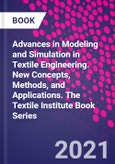Advances in Modeling and Simulation in Textile Engineering: New Concepts, Methods, and Applications explains the advanced principles and techniques that can be used to solve textile engineering problems using numerical modeling and simulation. The book draws on innovative research and industry practice to explain methods for the modeling of all of these processes, helping readers apply computational power to more areas of textile engineering. Experimental results are presented and linked closely to processes and methods of implementation. Diverse concepts such as heat transfer, fluid dynamics, three-dimensional motion, and multi-phase flow are addressed. Finally, tools, theoretical principles, and numerical models are extensively covered.
Textile engineering involves complex processes which are not easily expressed numerically or simulated, such as fiber motion simulation, yarn to fiber formation, melt spinning technology, optimization of yarn production, textile machinery design and optimization, and modeling of textile/fabric reinforcements.
Please Note: This is an On Demand product, delivery may take up to 11 working days after payment has been received.
Table of Contents
1 Overview of modeling and simulation in textile engineering 2 Modeling classification of textile engineering problems 3 Neural networks in textile engineering 4 Genetic algorithms and evolution strategy in textile engineering 5 Turbulence models for simulation and modeling in textile engineering 6 Modeling and simulation applications in yarn formation technology 7 Fiber motion and fibrous material processesdmodeling and simulation 8 Classical challenges in modeling and simulation in textile engineering 9 Modeling of the electrospinning process 10 Case studies of modeling and simulation in textile engineering 11 Modeling of reinforcement fibers and textiles 12 Modeling and analysis of laminated composites: classical and contemporary approaches 13 Simulation and modeling of the braiding process 14 Prediction and modeling of fabric properties from yarn and fabric structure 15 Theoretical formulation and modeling of textile-reinforced concrete








